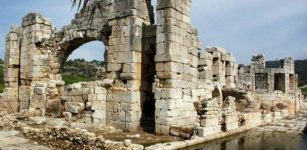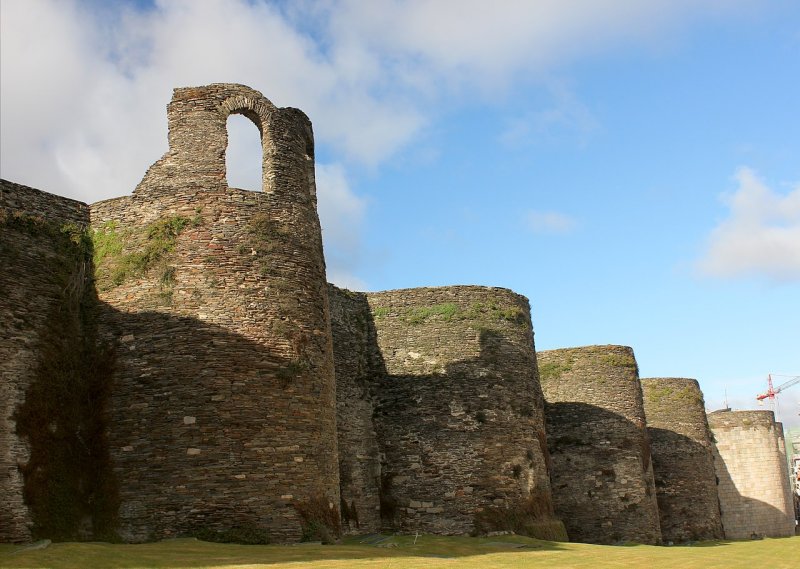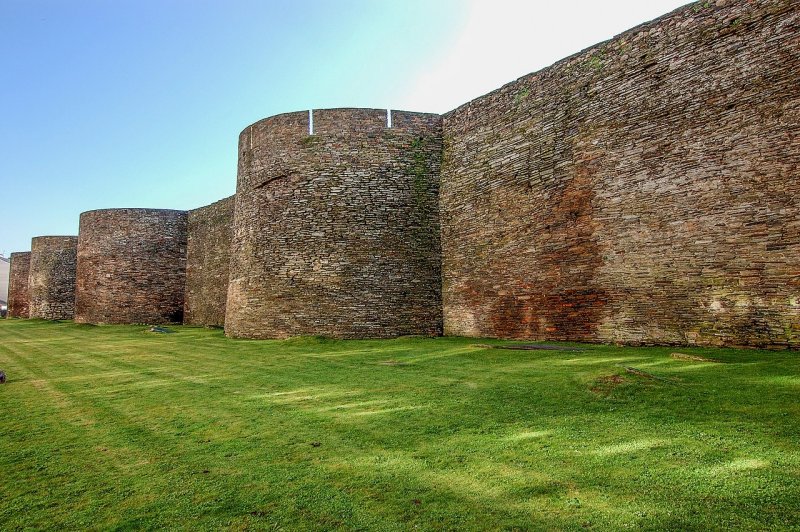Walls Of Lugo: Finest Example Of Late Roman Fortifications – Stands The Test Of Time
A. Sutherland - AncientPages.com - The Roman city walls in Lugo, Spain, are considered the only Roman structure that experienced the powerful empire's domination, yet it is still in perfect condition.
Roman wall of Lugo - Image credit: Xosema - CC BY-SA 4.0
The Lugo structure – dated to the end of the 3rd century - was once part of a defensive complex that included walls, a moat, and an intervallum.
According to UNESCO, the Roman walls of Lugo are 'the finest surviving example of late Roman military fortifications.' We have described on Ancient Pages.com several ancient Roman walls and structures. Still, the Lugo is something extraordinary because the construction of this foundation has survived intact for eighteen centuries.
The structure will stand the test of time even much longer.
The Lugo City Walls are another architectural, archaeological, and constructive accomplishment of Roman engineering, dating from the 3rd and 4th centuries AD.
The Lugo walls - dated from the end of the 3rd century - cover ca. 34.4 hectares, with an impressive perimeter of about 2,120 meters. Its walls are 4.2 meters, and its height ranges from 8 to 12 meters. It was built to defend the Roman city of Lucus Augusti against the barbarian threat.
Roman walls, Lugo, Spain. Image credit: ResearchGate
The ancient Romans' building materials included mortar made from earth, loose stones, and pebbles cemented with water.
The ancient Roman builders' massive and still spectacular work has 71 sections (60 circular and 11 quadrangular) and two-story towers.
The walls still contain 85 external towers, and access to Lugo's interior area is possible through ten gates, five of which were continuously opened from 1853.
Construction of the walls started in 265 AD and was finally completed in 310 AD.
During this period, much of Roman Hispania was threatened by foreign invasion. It is believed, however, that the wall was built to defend the city from revolts by local tribes rather than foreign invaders.
Lugo, Galicia, Spain. Image credit: Rosa Cabecinhas & Alcino Cunha (Rosino) - Flickr
Despite the imposing nature of the Roman Wall, it was damaged on many occasions. In the fifth century, a large group of Germanic peoples (Germanic Suevi) from the Elbe River region in Germany and the Czech Republic invaded Lugo town.
When the Moors invaded Spain, Lugo was ravaged in 714 but was recaptured by Alfonso I of Asturias in 755. Then, in 457, it was invaded by the Visigoths, who captured and settled the town.
Over 200 years later, the Normans again attacked the town in 968, which was restored in the following century.
The Roman city walls in Lugo have a long, dramatic history. They are the finest surviving examples of late Roman military fortifications.
The Walls of Lugo remains an impressive landmark of the Roman-Galician city and its long history that prevails around it.
Written by – A. Sutherland - AncientPages.com Senior Staff Writer
Updated on January 25, 2024
Copyright © AncientPages.com All rights reserved. This material may not be published, broadcast, rewritten or redistributed in whole or part without the express written permission of AncientPages.com
Expand for referencesMore From Ancient Pages
-
 Was King William II Murdered In The New Forest?
Featured Stories | Aug 5, 2021
Was King William II Murdered In The New Forest?
Featured Stories | Aug 5, 2021 -
 Ornamental Bronze Wall Plate Unearthed In Ayanis Castle Built By Urartian King Rusa II
Archaeology | Sep 13, 2022
Ornamental Bronze Wall Plate Unearthed In Ayanis Castle Built By Urartian King Rusa II
Archaeology | Sep 13, 2022 -
 Ancient Mystery Of The American Southwest – Unusual Skeletons And Mummies – Part 2
Ancient Mysteries | Jul 24, 2018
Ancient Mystery Of The American Southwest – Unusual Skeletons And Mummies – Part 2
Ancient Mysteries | Jul 24, 2018 -
 Largest Capstone Ever Found In South India
Archaeology | Mar 24, 2017
Largest Capstone Ever Found In South India
Archaeology | Mar 24, 2017 -
 Huge Ancient Sarayini Underground City Is Twice As Large As Previously Thought
Archaeology | Aug 22, 2023
Huge Ancient Sarayini Underground City Is Twice As Large As Previously Thought
Archaeology | Aug 22, 2023 -
 Who Were The Blue People Of Kentucky?
Featured Stories | Apr 5, 2022
Who Were The Blue People Of Kentucky?
Featured Stories | Apr 5, 2022 -
 Knights Templar’s Mysterious Underground Chambers Hidden In The Caynton Caves Discovered
Archaeology | Apr 13, 2021
Knights Templar’s Mysterious Underground Chambers Hidden In The Caynton Caves Discovered
Archaeology | Apr 13, 2021 -
 Why Did Neolithic Make Us Taller And More Intelligent But More Prune To Heart Disease?
Archaeology | Apr 8, 2022
Why Did Neolithic Make Us Taller And More Intelligent But More Prune To Heart Disease?
Archaeology | Apr 8, 2022 -
 Migrants From Turkey And Greece Arrived In Britain Some 6,000 Years Ago
Archaeology | Apr 16, 2019
Migrants From Turkey And Greece Arrived In Britain Some 6,000 Years Ago
Archaeology | Apr 16, 2019 -
 Limestone Stela Of Liberation Discovered In Kom Ombo Temple In Aswan, Egypt
Archaeology | Oct 17, 2018
Limestone Stela Of Liberation Discovered In Kom Ombo Temple In Aswan, Egypt
Archaeology | Oct 17, 2018 -
 Unique Ancient Roman Boxing Gloves Discovered Near Hadrian’s Wall – The Only Surviving Example From 120 A.D.
Archaeology | Feb 20, 2018
Unique Ancient Roman Boxing Gloves Discovered Near Hadrian’s Wall – The Only Surviving Example From 120 A.D.
Archaeology | Feb 20, 2018 -
 Puzzling Case Of An Ancient French Giant Whose Bones Caused Sensation And Controversy
Ancient Mysteries | Jan 22, 2019
Puzzling Case Of An Ancient French Giant Whose Bones Caused Sensation And Controversy
Ancient Mysteries | Jan 22, 2019 -
 Petronella Oortman And Her Giant Dolls’ House
Featured Stories | Jul 10, 2019
Petronella Oortman And Her Giant Dolls’ House
Featured Stories | Jul 10, 2019 -
 City Of Patara: Long History Of Wars And Visits Of Prominent Figures Of Ancient World
Archaeology | Jul 9, 2020
City Of Patara: Long History Of Wars And Visits Of Prominent Figures Of Ancient World
Archaeology | Jul 9, 2020 -
 Underwater Archaeologists Retrieve Over 100 Magnificent Glass Objects at Chengene Skele Bay, Bulgaria
Archaeology | Jul 16, 2024
Underwater Archaeologists Retrieve Over 100 Magnificent Glass Objects at Chengene Skele Bay, Bulgaria
Archaeology | Jul 16, 2024 -
 Palace From The Time Of The Kings Of Judah – Unearthed In Jerusalem
Archaeology | Sep 5, 2020
Palace From The Time Of The Kings Of Judah – Unearthed In Jerusalem
Archaeology | Sep 5, 2020 -
 Scientists Found Mysterious Prophecies In Ancient Egyptian Pyramid – Are They Linked To The Strange Visions Some Experience Inside?
Featured Stories | Dec 17, 2024
Scientists Found Mysterious Prophecies In Ancient Egyptian Pyramid – Are They Linked To The Strange Visions Some Experience Inside?
Featured Stories | Dec 17, 2024 -
 Why Is This Centaur Head A Scientific Mystery?
Archaeology | Jan 19, 2024
Why Is This Centaur Head A Scientific Mystery?
Archaeology | Jan 19, 2024 -
 Massive Underground Anomaly – Iron Ages Temples And Seat Of Legendary Ulster Kings Discovered At Navan Fort?
Archaeology | Jul 21, 2020
Massive Underground Anomaly – Iron Ages Temples And Seat Of Legendary Ulster Kings Discovered At Navan Fort?
Archaeology | Jul 21, 2020 -
 Harappan Civilization Built Massive Protection Walls Against Tsunami 5,000 Years Ago
Archaeology | Jan 10, 2017
Harappan Civilization Built Massive Protection Walls Against Tsunami 5,000 Years Ago
Archaeology | Jan 10, 2017



